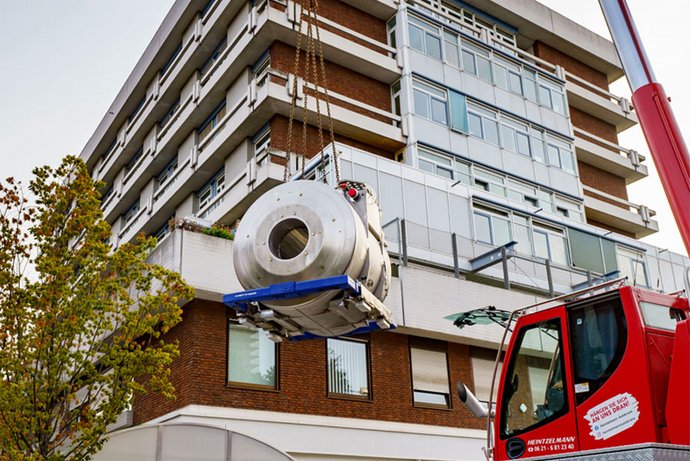A milestone for neuropsychiatric research in Mannheim: the Central Institute of Mental Health (CIMH) now has a new, state-of-the-art brain imaging device. The 7-tesla magnetic resonance imaging (MRI) scanner enables unprecedented resolution in imaging structures and functions in the human brain. The aim is to gain an even better understanding of the causes and mechanisms of mental illnesses and, based on this, to develop new, individualized treatment approaches. The Klaus Tschira Foundation is making the acquisition possible.
A central research approach at the CIMH is to investigate the mode of action of new therapies using functional biochemical and structural imaging techniques. By making brain functions visible, psychiatric and psychological therapy research can focus on essential aspects of diseases at the neuronal level. Information processing disorders often become visible at the neuronal level even when these processes have not yet shown up in behavior or can no longer be distinguished there. These markers can be tested for their usefulness in therapy research using modern mathematical methods and then applied.
Decisive advantages for therapy research
“Particularly in the case of new treatments, specific effects in the affected brain systems can be measured and described in the brain in this way,” says Prof. Dr. Andreas Meyer-Lindenberg, chairman of the board of the CIMH. “This enables statements for personalized medicine, which is particularly urgent in this area because psychiatric diagnoses do not sufficiently distinguish between subgroups of patients relevant for treatment.”
The 7-tesla Magnetom Terra.X MRI from Siemens Healthineers is capable of imaging not only fine brain structures but also activity and metabolic processes with previously unattainable precision. In the field of therapy research, this allows the presence and distribution of molecules in the brain – for example, new drugs – to be measured directly. At the same time, the effects on brain function can be visualized. Particularly in psychiatric therapies, which often target very small areas in the brain, the high-resolution imaging is an important advantage. “We are very grateful to the Klaus Tschira Foundation for its funding, which enables us to continue our ambitious research program with the necessary infrastructure,” emphasizes Meyer-Lindenberg.
Part of the unique ZIPP
The new device is the world's first 7 Tesla MRI Magnetom Terra.X from Siemens Healthineers with patient certification in psychiatry. It will be part of the Center for Innovative Psychiatry and Psychotherapy Research (ZIPP), which opened in 2019 in the Therapy Building in J 5. Here, a comprehensive research infrastructure is located in direct connection to the hospital rooms. The short distances make it possible to conduct research even with seriously ill patients. The ZIPP will not only be used by researchers at the CIMH, but is also a central component of the newly established, nationwide German Center for Mental Health.
20 tons float helium-cooled through the air
Like all MRI machines, the 7 Tesla MRI requires special structural accommodation. The required space was already provided for in the basement of the therapy building during the planning of the ZIPP. The superconducting magnet, which weighs about 20 tons, has now been brought into the building in J 5 through an opening in the ceiling. At this point, the magnet is already being cooled with liquid helium, but is not yet ready for use. The commissioning work will be completed by the end of October, so that the technical introduction for the scientists involved can begin in early November.
Imaging research at the CIMH – always pioneering work
In the mid-1990s, the CIMH was one of the first institutes to install an MRI machine for diagnostics and neuropsychiatric research. Thus, the CIMH was already active in this field in the pioneering days of metabolic and functional imaging. Since 1998, the MRI has been used exclusively for human brain research. The replacement of the 1.5 Tesla MRI (2005) and the addition of a second 3 Tesla unit (2009) created the conditions for social interaction studies. For this, CIMH scientists connected the two MRIs to simultaneously measure the brain activity of two people who were interacting with each other or working together to solve a task. Magnetic resonance imaging has also been used in animal research since 2008. The much smaller brains of rats and mice compared to humans require significantly stronger magnetic fields (9.4 Tesla) for imaging. Again, anatomy, function and biochemistry are being studied. For molecular imaging, the CIMH also installed a combined positron emission/magnetic resonance imaging (PET-MRI) scanner on the ZIPP premises in 2017.


